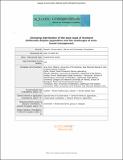Files in this item
Changing distribution of the east coast of Scotland bottlenose dolphin population and the challenges of area-based management
Item metadata
| dc.contributor.author | Arso Civil, Monica | |
| dc.contributor.author | Quick, Nicola Jane | |
| dc.contributor.author | Cheney, Barbara | |
| dc.contributor.author | Pirotta, Enrico | |
| dc.contributor.author | Thompson, Paul M | |
| dc.contributor.author | Hammond, Philip Steven | |
| dc.date.accessioned | 2020-09-05T23:34:20Z | |
| dc.date.available | 2020-09-05T23:34:20Z | |
| dc.date.issued | 2019-09-06 | |
| dc.identifier | 255391852 | |
| dc.identifier | 06f2e435-986c-4b6d-ab15-4202677b6cee | |
| dc.identifier | 85071780348 | |
| dc.identifier | 000484997200013 | |
| dc.identifier.citation | Arso Civil , M , Quick , N J , Cheney , B , Pirotta , E , Thompson , P M & Hammond , P S 2019 , ' Changing distribution of the east coast of Scotland bottlenose dolphin population and the challenges of area-based management ' , Aquatic Conservation: Marine and Freshwater Ecosystems , vol. 29 , no. S1 , pp. 178-196 . https://doi.org/10.1002/aqc.3102 | en |
| dc.identifier.issn | 1052-7613 | |
| dc.identifier.other | ORCID: /0000-0002-2381-8302/work/61621985 | |
| dc.identifier.other | ORCID: /0000-0001-8239-9526/work/61622213 | |
| dc.identifier.uri | https://hdl.handle.net/10023/20553 | |
| dc.description | MAC received funding from the Department of Energy and Climate Change (DECC) (now Department for Business, Energy and Industrial Strategy) UK, and the MASTS (Marine Alliance for Science and Technology for Scotland) pooling initiative. MASTS is funded by the Scottish Funding Council (grant reference HR09011) and contributing institutions. Annual surveys were funded by DECC, Scottish Natural Heritage (SNH), Beatrice Offshore Windfarm Ltd., Moray Offshore Renewables Ltd, Marine Scotland, The Crown Estate, Highlands and Islands Enterprise and the Universities of St Andrews and Aberdeen. | en |
| dc.description.abstract | 1. The efficacy of marine protected areas (MPAs) depends on clear conservation objectives and ecologically meaningful boundaries. The east coast of Scotland bottlenose dolphin population expanded its distributional range during the 1990s beyond the boundaries of the Moray Firth Special Area of Conservation (SAC), originally proposed to contain their core area of distribution. Two decades on, this study assesses the importance for this population of St Andrews Bay and the Tay estuary, 300 km south of the SAC. 2. Photoidentification data from 2009 to 2015 were analysed using mark–recapture models to investigate the proportion of the population that uses St Andrews Bay and the Tay estuary. Habitat models were fitted to bottlenose dolphin presence–absence data to identify areas of high use. 3.The estimated number of dolphins using St Andrews Bay and the Tay estuary during the summer increased from 91 (95% confidence interval 78–106) in 2009 to 114 (95% confidence interval 95–137) in 2015, representing, on average, 52.5% of the total estimated east‐coast population for that period. Spatial mixing of individuals during the summer between St Andrews Bay and the Tay estuary and the Moray Firth SAC was estimated to be a minimum of ~6% per year and ~30% over the study period. The entrance to the Firth of Tay and waters around Montrose were identified as areas of consistent high use. 4. The importance of St Andrews Bay and the Tay estuary reconfirms that effective monitoring of the population requires dedicated effort in both this area and the SAC. The results lead to consideration of the wider context of area‐based management for the conservation/management of highly mobile wide‐ranging species and human activities that might impact them. | |
| dc.format.extent | 19 | |
| dc.format.extent | 1875544 | |
| dc.language.iso | eng | |
| dc.relation.ispartof | Aquatic Conservation: Marine and Freshwater Ecosystems | en |
| dc.subject | GC Oceanography | en |
| dc.subject | GF Human ecology. Anthropogeography | en |
| dc.subject | QH301 Biology | en |
| dc.subject | NDAS | en |
| dc.subject | SDG 14 - Life Below Water | en |
| dc.subject.lcc | GC | en |
| dc.subject.lcc | GF | en |
| dc.subject.lcc | QH301 | en |
| dc.title | Changing distribution of the east coast of Scotland bottlenose dolphin population and the challenges of area-based management | en |
| dc.type | Journal article | en |
| dc.contributor.institution | University of St Andrews. Sea Mammal Research Unit | en |
| dc.contributor.institution | University of St Andrews. School of Biology | en |
| dc.contributor.institution | University of St Andrews. Marine Alliance for Science & Technology Scotland | en |
| dc.contributor.institution | University of St Andrews. Scottish Oceans Institute | en |
| dc.contributor.institution | University of St Andrews. Centre for Research into Ecological & Environmental Modelling | en |
| dc.identifier.doi | 10.1002/aqc.3102 | |
| dc.description.status | Peer reviewed | en |
| dc.date.embargoedUntil | 2020-09-06 |
This item appears in the following Collection(s)
Items in the St Andrews Research Repository are protected by copyright, with all rights reserved, unless otherwise indicated.

